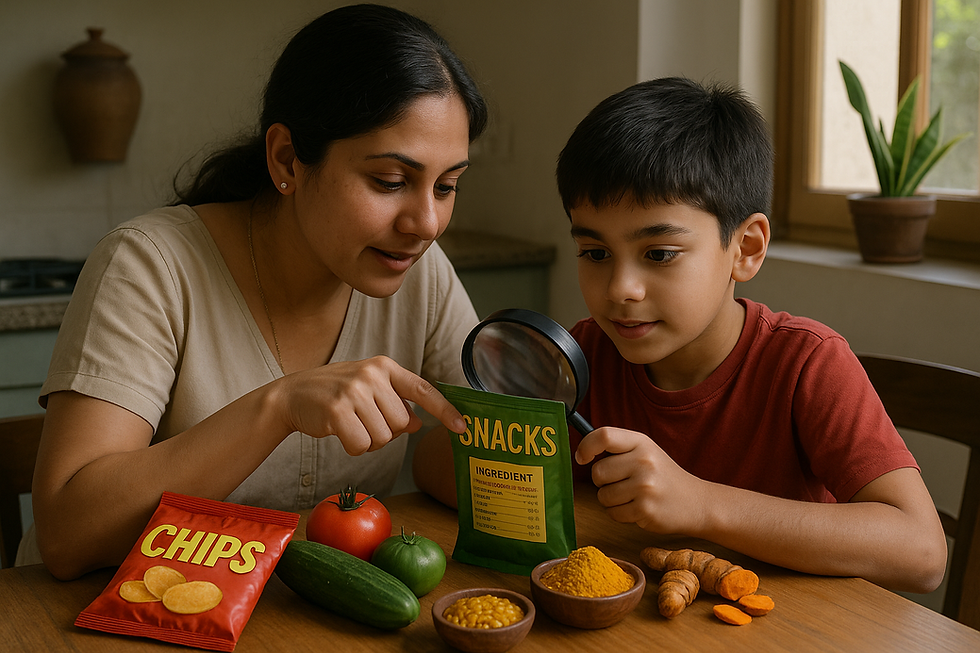Complementary Feeding for 6-7 Months
- Dr Tejal Risbud Rao

- Jan 15
- 3 min read
Your Baby’s First Spoonful: A Joyful Milestone!

At six months, your little one is ready for an exciting milestone—their first taste of solid food! Breast milk continues to be vital, providing essential nutrition, antibodies, and healthy fats for brain development. However, as your baby grows, complementary feeding becomes necessary to meet evolving nutritional needs while continuing breastfeeding.
Why Start at 6 Months?
By six months, breast milk alone may no longer supply all the nutrients your baby needs. Starting solids at this stage supports healthy growth and helps develop essential feeding skills. Here's why it’s the perfect time:
Neck and Head Control: Your baby can now hold their head steady and sit with support.
Mouthing and Biting: Babies begin enjoying mouthing objects and gumming soft foods as teeth start emerging.
Digestive Readiness: The intestines are mature enough to handle cereals and pulses.
Chewing Skills: Early chewing movements emerge, and the tongue’s side-to-side motion develops.
Reduced Tongue Thrust Reflex: Your baby can better manage to swallow solids.
What to Start With: Gentle First Foods
The first foods should be nutrient-dense, easy to digest, and gentle on your baby’s tummy. Start with single-ingredient options to introduce new tastes and textures gradually.
Single-grain cereals: Rice porridge, ragi porridge
Mashed fruits: Banana, apple, pear (rich in vitamins and fibre)
Cooked, mashed vegetables: Carrot, pumpkin, sweet potato, bottle gourd
Liquids: Homemade rice water, dal water
Sample Meal Plan:
Breakfast (9:00 AM): Rice porridge (2 tablespoons) mixed with breast milk
Afternoon Snack (12:00 AM): Mashed banana/ mashed sweet potato puree (2 tablespoons)
Evening meal (4:00 PM): Ragi porridge
Texture Matters! Begin with smooth, runny purees. These are easier for your baby to swallow and help avoid gagging. As your baby grows, gradually introduce thicker purees and soft mashed foods.
How Often Should You Feed?
Start small and follow your baby’s cues:
Begin with 1-2 tablespoons once a day.
Gradually increase as your baby shows interest and readiness.
Pro Tips for a Happy Feeding Experience:
Feeding should be a joyful bonding experience filled with patience and positivity:
Introduce one food at a time with a 3-day gap to monitor for allergies.
Avoid salt, sugar, and honey for the first year.
Sit your baby in a comfortable, upright position, propped up against your chest till they are ready to sit independently.
Encourage self-feeding when your baby is ready.
Foods to Avoid:
Salt and sugar: Strain the kidneys.
Honey: Risk of infant botulism.
Whole nuts, grapes, and hard foods: Choking hazards.
Packaged foods and sugary snacks: Nutritionally inadequate.
Responsive Feeding: Building Healthy Habits
Feeding time is more than just nutrition—it’s about emotional bonding and learning.
Make eye contact and talk to your baby while feeding.
Allow self-feeding when possible.
Avoid comparing eating habits with other children.
Don’t force-feed. Let your baby guide the pace.
Homemade vs. Commercial Foods:
While commercial baby foods are widely available, they often make exaggerated health claims and can be expensive. Whenever possible, prepare fresh, home-cooked meals using local ingredients. Homemade food is often safer, healthier, and more cost-effective.
Key Principles of Complementary Feeding:
Start after 180 days of exclusive breastfeeding.
Continue breastfeeding alongside solids until 2 years.
Begin with semi-solid foods like porridge and mashed veggies.
Avoid watery foods like soups and juices.
Respect your baby's preferences—don’t force feed.
Use a balanced mix: cereal + pulses + vegetables.
Remember: Every baby is unique! Observe your little one’s cues, go slow, and make this feeding journey a delightful experience filled with love and care.
FAQs:
When can I introduce water? After six months, small sips of water can be offered along with solids.
What if my baby refuses food? Try different textures and foods patiently. Avoid force-feeding.
Is homemade food better than commercial baby food? Yes, homemade food is fresher, safer, and free of preservatives.
Are some foods ‘hot’ or ‘cold’? There is no such concept in modern medicine. In many communities, there are deep-rooted beliefs, taboos, or misconceptions that some foods are cold or hot.
Need personalized guidance?
The author is a senior Pediatrician and Neonatologist practicing in Bangalore, India. For specific advice on your child’s nutrition, feel free to reach out.
Contact us:
To schedule a one-on-one consultation with one of our in-house experts, please drop an email at happykidspeds@gmail.com. You can also visit our clinic in JP Nagar or book an appointment online (+91 90196 48019).
If you’d prefer a quick summary of this article, you can download the below pdf for easy reference.





Comments